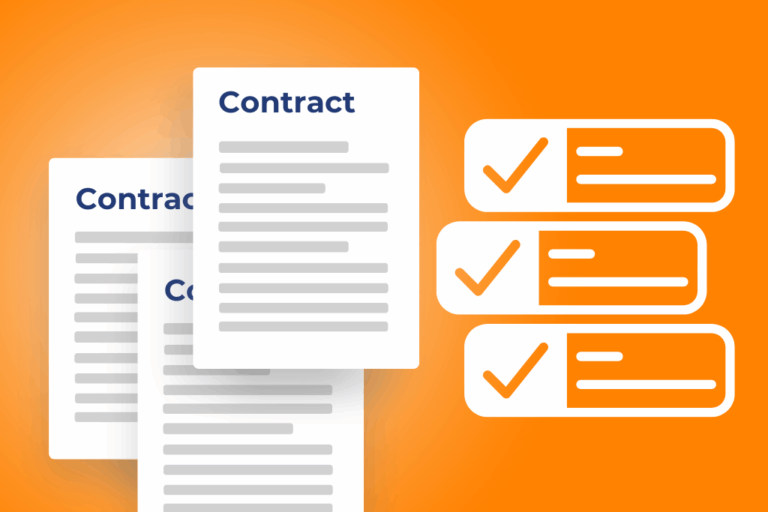Today, electronic signatures are one of the essential technological tools for digitizing contractual processes. It is not just for lawyers, but for all professionals who need to have contracts signed: purchasing, sales, human resources, finance… many find it simple and fast. But did you know that combining electronic signature and CLM offers other advantages? Let’s find out exactly what this means, and how you can make the most of it on a daily basis.
From paper to electronic signature
The electronic signature makes it possible to dematerialize the signature process. In concrete terms, it means being able to sign a contract without needing a paper version. This means that even if the parties are thousands of kilometers apart, they can conclude an agreement with just a few clicks of the mouse. The benefit is twofold: not only does it make it possible to contract remotely, but it also shortens signature times by avoiding postal delivery, or simply printing and scanning a document in transit by e-mail.
Of companies with 500 or more employees, 1 in 2 has adopted an electronic signature tool.
Survey conducted by OpinionWayfor Oodrive in February 2020.
The question of legal value often comes up when discussing this innovation. On this point, the French Civil Code is clear: electronic signatures have the same legal value as handwritten signatures. And it is regulated at European level by the eIDAS regulation, which recognizes three levels of signature.
Electronic signature: dematerializing the internal validation process
Now you know what electronic signatures are, but are you familiar with the “digital signature manager” – also known as the “validation workflow” in technology jargon? Quite simply, it’s a matter of dematerializing the internal contract approval process before having the contract signed. In the absence of a technological tool, this can be a time-consuming process: the paper initials pass through several hands within the company, multiple emails are exchanged, and version changes are the source of numerous back-and-forth processes, all of which delay the conclusion of the agreement. And yet, proper internal validation is an essential step before committing the company to a new relationship. In this context, validation workflows reconcile the need to secure agreements with the need to adapt to the ever-accelerating pace of business.
In fact, they enable you to keep track of the document at all times within your contract management software: at any time, you know where the contract stands, who has validated or commented on it, and what the current version is. In turn, the various protagonists are automatically notified by email. Certain conditions can also be added: for example, including a specific person in the approval process to ensure that the delegation of authority is respected above a certain amount. These conditional workflows enable processes to be automated and secured according to certain criteria
In addition to the reliability provided by traceability, remote validation makes collaboration more fluid and speeds up the process. Wherever the various stakeholders are located, all they need to do is access their secure online space to consult, comment on and validate the document.
Why combine electronic signatures with contract management software?
Signing is a central stage in the contract life cycle. It is preceded by drafting, negotiation and validation, and followed by monitoring, renewal and analysis. This is why it makes sense to integrate the electronic signature into software that manages all contractual processes, centralizing all contract processing flows and up-to-date information.
Before signing
Some contract management software packages integrate the electronic signature directly into the validation workflow. This is the case with our CLM solution: once the contract has been approved within the solution, simply launch the electronic signature request, and the other party will be informed by email. They can then sign the contract directly in the electronic signature platform (in our case, Docusign or Dropbox Sign), without having to register.
There’s no need to import, export or archive your contract in other digital work environments, or even to print it out and send it to your partner… Here, the process is simplified and the information centralized. All it takes is a few clicks to complete the contracting process.
DID YOU KNOW?
By digitizing the drafting and negotiation stages within your contract management software, you can speed up the contracting process. Here are just a few examples of our features:
- Contract request forms empower employees while retaining control of the legal department. There’s no need to hunt around for the information required for drafting, and exchanges are much smoother.
- The common clausier enables the lawyer to add clauses already approved internally with a single click, thus guaranteeing compliance. During negotiations, access to previously executed contracts and advanced search functions enable the negotiated terms to be compared to obtain the best deal.
- Co-publishing the same document allows several people to work on the contract, without losing comments and versions.
After signature
What happens once the contract is signed? Without contract management software, all parties receive a copy of the contract by email. It’s up to each party to put the contract in the right folder, and to note the important information to be followed during its execution.
With a contract management solution, the signed contract is automatically loaded into the right place in your software, and you are notified. Once again, information is centralized.
If your software makes use of artificial intelligence, you don’t need to enter the key information that the contract contains: the signature date, the “signed” status, the other party’s information, the end date, etc. All the important data to be tracked during execution is already identified in your software. In concrete terms :
- They appear in the contract summary sheet: at a glance, you’ll find all the important elements, without having to go through the entire document.
- All that’s left to do is schedule reminders on the suggested dates with a single click, so that you don’t forget any obligation – such as the renewal date, for example!
- The key information contained in your contract is also available via the search engine, which will help you to find any document later, according to multiple criteria (type, clause, date, party, amount, applicable law…).
- Finally, the statistical dashboard lets you monitor contract activity in real time – for example, the number of contracts signed during a given period, the number of contracts due to expire within a given timeframe, and so on.
How do you combine the two technologies?
If you’ve already taken the electronic signature plunge (usually a subscription is all you need), you should know that the major players in the field have already built partnerships with contract management software. For example, Docusign and Dropbox Sign are seamlessly integrated into DiliTrust’s contract management solution. If you already have a Docusign or Dropbox Sign account, the connection to DiliTrust is instantaneous. We can even integrate your electronic signature partner, whoever it may be, at your request.
If, on the other hand, you still haven’t found what you’re looking for, we recommend that you first look for an all-in-one solution. Contract management software that integrates electronic signatures will simplify all your company’s contractual processes from the outset, whereas electronic signatures alone will only enable you to optimize one stage in the contract life cycle.
Of course, equipping yourself with a global solution requires a bit of thought to properly identify your current issues and future needs, but it will save you precious time in the long run. Internal validation workflows, due date reminders, centralized remote access to all your contracts… these are just some of the benefits.
In short, by integrating electronic signatures with contract management software, you can harness the full potential of digital tools to support your company’s contractual activities. This combination secures, accelerates and simplifies upstream contractualization and downstream follow-up processes. It not only facilitates collaboration between the various stakeholders (both internal and external), but also centralizes data from one end of the contract processing chain to the other.

